The weight of their past
By Aanchal Malhotra
The Friday Times 28 Nov 2014
Interviewing people whose memories are scattered across both sides of the Indo-Pak border, Aanchal Malhotra was alerted to the ways in which memory shapes our lives and what is at stake in the preservation of personal objects from the past
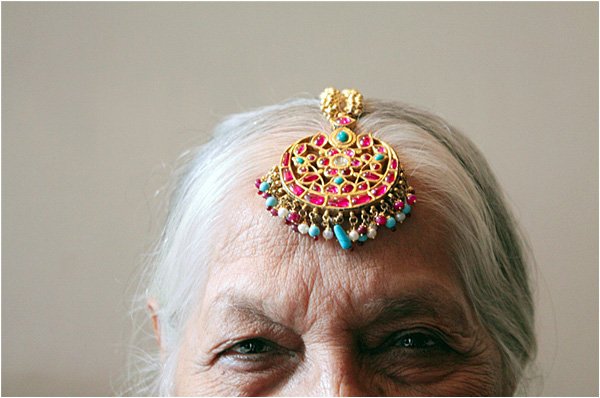
A maang-tikka brought across the border by the author's great grandmother (daadi's mother)
When I was young I never thought about the past; it barely ever weighed down on me. In fact, back then it was all about the now. The present felt absolutely delicate as if it would slip right through my fingers. The past, on the other hand, seemed heavy like concrete and despite its weight, much easier to store away and not consider. Only when I grew older, I understood that one could not exist without the other- the present rested on the shoulders of the past, and with this realization came an innate curiosity for myown past, my lineage. What was my history; my family’s history? Where did we come from? My grandparents migrated from [what became] Pakistan during the Partition, but this was a fact that I had always grazed over from a fairly removed perspective, only now delving deeper into it.

The gaz
The Partition was a definitive event in the history of many families
The Partition was a definitive event in the history of many families. It was used almost as a tool to archive, dividing lives into two phases: pre-partition and post. It not only aided the construction of personal identity, but also of nationality. The year 1947 saw the division of India, the creation of Pakistan and subsequently, cemented what the words Indian or Pakistani really meant. If nothing else, the partition made the question of citizenship one of utmost importance.
As families trudged across the Radcliffe Life on either side, gradually walking towards this new life and citizenship, they left a part of themselves behind, something intangible. Migration is often accompanied by a feeling of unavoidable displacement, and the circumstances of 1947 made this feeling exceptionally significant. In most cases, it created an involuntary distance between where one was born pre-partition and where one moved to after it, stretching out their identity sparsely over the expanse of this distance. As a result somewhere in between the original city of their birth and the now adopted city of residence lay their essence – strangely malleable.
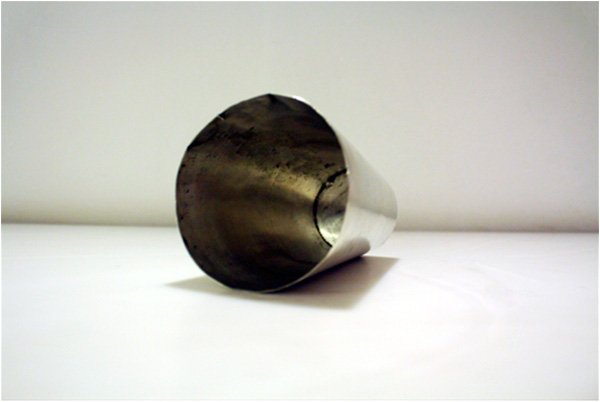
A tall silver glass once entrusted to a strong single woman’s care
The first time I considered this notion was when I heard my dadi talk about home
The first time I considered this notion was when I heard my dadi talk about home. I always thought home for us was in India, in South Delhi, in the old fashioned two-storey white house with the round marble staircase. And though that was home, it was where she lived and had lived for decades, it was the house she had built with my grandfather, it was not the place she thought of when she thought of ‘belonging’. In that regard, home was always the Frontier. She existed there as well, but in a very different form. That was her childhood, her ancestral house, where she ran through the fields, where she was taught the importance of education by her single mother, where she learned the worth of family – that was always the Frontier. It was her soil, her roots. And somewhere between the North-West Frontier and South Delhi, her essence lay scattered amidst the chaos of 1947.
What I noticed as she narrated her memories was that through they brought back the past, they simultaneously tore one up from the inside, causing pain. It was ironic that the most significant event in the creation of national identities of the subcontinent was one that the generation that experienced it, wanted to forget.

Portrait of the author’s great grandmother
Similarly, while speaking to my nana and his eldest brother, I came across another interesting, though minor, facet of the partition that eventually led to the subject of research for my masters’ thesis. Their relationship to the events of 1947 was interesting in that they migrated from Lahore much before and were based in Delhi during independence, witnessing riots all over the city. When I last visited them, I was aquatinted for the first time with two objects imperative to my ancestry. My nana and his brothers’ connections to the land of their birth were through objects – an old tarnished ghara and a yardstick that belonged to their parents and travelled with them from Lahore to Amritsar to Delhi. When the brothers spoke about these objects, their demeanor changed completely, becoming child-like, naïve, vulnerable while remembering the memories connected to them. They spoke of their mother and how she churned lassi in the ghara, they spoke of their father and how he deftly measured fabric with the gaz [the yardstick] in his clothing store in Lahore.
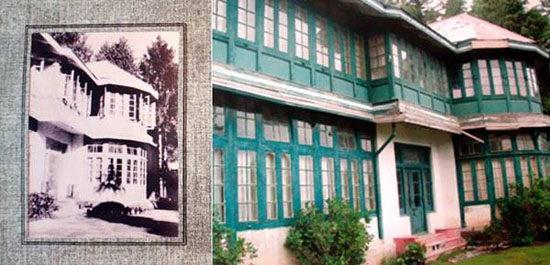
The Dalhousie house – then and now
What do you take when you don’t know what the journey ahead will be like
That was the first time I realized the ability an object had to retain memory. I began wondering more and more about the plight of refugees that crossed the border, what their conditions were, and – keeping my nana’s story and my dadi’s notions of belonging in mind – the objects that might have accompanied them on their journey. I had heard of the circumstances that many had to evacuate their homes in – the riots, the fires, the escapes to refugee camps in the middle of the night. Some had time to prepare, things to pack, but most had to leave on a moment’s notice. What could they have taken with them – grabbed whatever was in sight or something of sentimental value? What do you take when you don’t know what the journey ahead will be like – whether you will live to see tomorrow or not? What becomes your luggage, your baggage? Most often they brought nothing except for the clothes they wore and the assurance of having crossed the border safely.
But I was certain that if I searched enough, I would find objects that travelled with them, concealed and unseen. And if those objects still existed today after nearly seven decades of independence, they would not simply be mundane or banal, but serve as physical reminders of a true home, of family and of belonging. Some might even be considered heirlooms. The physical weight of the object would be outweighed by the emotional weight put into it over the years. In some ways, they would carry the weight of the past, of memory, of having crossed the distance and survived.
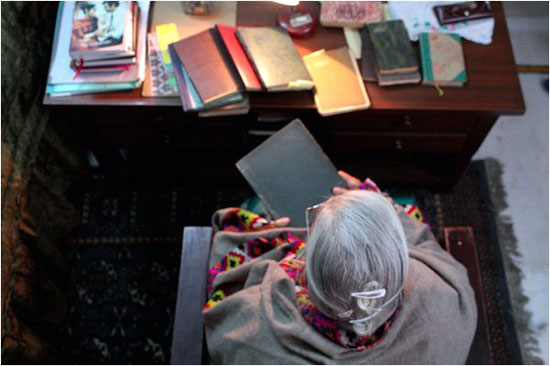
Journals bearing pre-partition tales
***
With this premise in mind, I explored the twin cities of Delhi and Lahore. The story of my nana’s ghara and gaz swam in my mind as I searched for objects as an antiquary would. I collected the histories and journeys of these objects as an archivist would. I found many things [some of which are elaborated below] and ultimately, they built an alternative archive of the Partition for me, one constructed solely by remnants.
*
A professor of literature at the Delhi College of Art was once a young boy raised in Lahore by a strong, single mother. Being from a wealthy family, she decided to work as a moneylender, ensuring that no one left her house empty-handed when they came for help. When the partition riots began, their house being the only Hindu house in a Muslim mohalla, was the first one to be set on fire. Inside the house, lay the belongings of many residents of the neighborhood, given to her as collateral. When the young boy and his family fled from the house, they grabbed whatever they could from those items. What remains with him now are an odd array of things: a tall silver glass, a soapdish and a cigarette case – all belonging to other people, and a rusty pair of metallic scissors belonging to his mother.
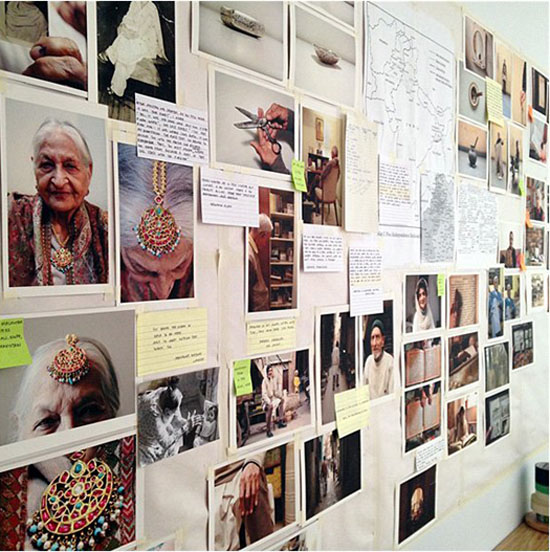
A work in progress
*
The beauty and isolation of the Langaryal village [distt. Gujarat] inspired a young girl to begin writing poetry at the age of eight. Cultivating this talent, she grew up to be a prominent Punjabi nationalist poet, winning the Sahiktya Academy Award as well as being honored with the Padmashree later in life. Displaced due to the riots in Punjab, her family travelled to independent India in 1947. Scattered across her bed and piled high on the writing desk in her Delhi home, lay before me the many journals that accompanied her [dating back to pre-partition]. In pristine condition as if unaltered by weather or time, these notebooks bear her simple handwriting in Punjabi, contain her notes, inscribed dates, thoughts and musings on the everyday on dog-eared, neatly lined pages.
*
A girl born in Lyallpur [now Faisalabad] spent her summers at the family cottage in the mountains of Dalhousie. It was a white house with aqua green window shutters, one that her father had built with his own hands with love and care, a fact she took pride in. When the subcontinent partitioned, the family was in Dalhousie and had to flee and all the girl could take of the house was a simple black and white photograph of its exterior. Because they had some time to prepare, her mother packed many of their belongings and sent them to [what became] Pakistan by train. The family travelled from Dalhousie to Gurgaon to Mianwali and finally found their home in Lahore. In her grand living room in Gulberg, she showed me the old photograph, comparing it with one a relative had taken recently – the house looking exactly the way it did in 1947, yet now belonging to someone else. Along with the photograph on the table lay utensils, handcrafted in Kashmir, kept in their cottage in Dalhousie and sent to Pakistan on the goods train.
*

Tales of yore – from Ludhiana to Lahore
He was born in Ichhra, Lahore but moved to Ludhiana at a young age
He walked through the narrow passageway and I heard him say, “beta, woh number 16 wala liffafa toh lana”. A publisher’s son, he was born in Ichhra, Lahore but moved to Ludhiana at a young age due to his father’s work. When the riots broke out, the family moved back to Lahore, fleeing for their lives. They took nothing except books. His father only carried with him the books that he had published, instilling in his son, the love for the written word. And now, carefully curated, numbered and stored away in individual polythene bags, he kept alive his father’s legacy.
***
Each time I discovered a new object, unraveled its story, grazed its surface, I found a wealth of memories it held within. Each object laid claim to a past, and as the person who owned it began to talk about that past, I was amazed at their ability to remember every detail connected with it, with their childhood, with the Partition. I found it sad as slowly I realized that perhaps my generation has forgotten how to remember. We have forgotten how to store in our minds the minor aspects of life – those that bind us to others – secrets, feelings, memories. We don’t pay enough attention to our surroundings simply because we don’t need to. Times have changed, we have so many new gadgets to remember things for us, to record, to archive and arrange our everyday so systematically that our brain rarely has to exercise its powers of recollection for the mundane. When I compare this to the generation I interviewed, I am astonished at the particularities presented to me – everything from what the person wore as they fled from their home, to the height of the grass in the fields one ran through.
![Description: In-progress studio display [2014] of all the objects found from India and Pakistan](pictures/index_clip_image010.jpg)
In-progress studio display [2014] of all the objects found from India and Pakistan
Memory is a powerful thing. It is precious. The memory of something lives on long after it has died, and through it, we keep our past alive. Every single person I spoke with regarding this project had kept someone alive through the things they left behind, the things associated with them. It was important for me to see how in their own ways, decades after independence, they had preserved their homes, their childhoods, their sense of belonging. And strangely, how the smallest of objects could contain this heaviness of their experiences, this weight of their past.
- See more at: http://www.thefridaytimes.com/tft/the-weight-of-their-past/#sthash.VDk0y4fz.dpuf